Birdwatch: It's cone alone for the birds on a very strict diet


They eat almost nothing else and their remarkable beaks are perfectly adapted for this need.
Crossbills prefer cones that are starting to open but can also force open those that are tightly closed as long as the seeds inside are ripe.
Advertisement
Hide AdAdvertisement
Hide AdA flock, the males a bright red, females a greenish grey, will break off cones which they grasp in their claws.
The top of the beak is inserted behind one of the scales and the lower mandible to one side forcing the scale to widen. The seeds are them extracted with the crossbill’s long tongue.
Timing is crucial for the crossbill for, if the cones have fully opened and the seeds fallen to the ground, its beak makes it virtually impossible to pick these up.
Crossbills also feed their young on the seeds and, depending on their availability, will start breeding in August and continue rearing successive broods throughout the winter regardless of the weather.
Advertisement
Hide AdAdvertisement
Hide AdIn some years there can be invasions of crossbills, or irruptions as they are known, from Europe after the cone crop fails there. There is no evidence that this has happened this year, instead it looks is if our resident birds have taken advantage of a plentiful food supply.
Glaucous and Iceland gulls are being reported among gull flocks across the region with both species reported at Swillington Ings Leeds.
A first winter glaucous gull, found injured by the roadside at Flamborough on January 1 after being hit by a car was taken into care at the Ryedale Wildlife Rehabilitation Centre.
It was released last Friday at Rufforth tip near York after being ringed – four other glaucous and an Iceland gull have been seen there.
Advertisement
Hide AdAdvertisement
Hide AdMore tundra bean geese have been reported across the region with one flock of 36 of these scarce visitors from eastern Europe at Seamer Carrs near Scarborough and smaller numbers elsewhere. There have also been more white-fronted geese while skeins of pink-footed geese have been on the move across the county.
Two great northern, and a red-throated diver and two black-necked grebes have been seen inside Scarborough harbour and a great northern diver on Hornsea Mere. Two long-tailed ducks were in South Bay Scarborough while one was still at Skelton Lake, Leeds and another at Tophill Low.
At Fairburn Ings a water rail is being seen regularly from the Kingfisher Screen swimming out in search of small fish. At least eight others have been seen around the reserve.
Cetti’s warblers are being reported in a number of places with five calling or singing on the Potteric Carr reserve, Doncaster and others on the Blacktoft Sands.
Flocks of waxwings are becoming even more widespread as they roam in search of berries. With many rowan trees now bare they will be visiting more gardens in search of berries from cotoneaster bushes.